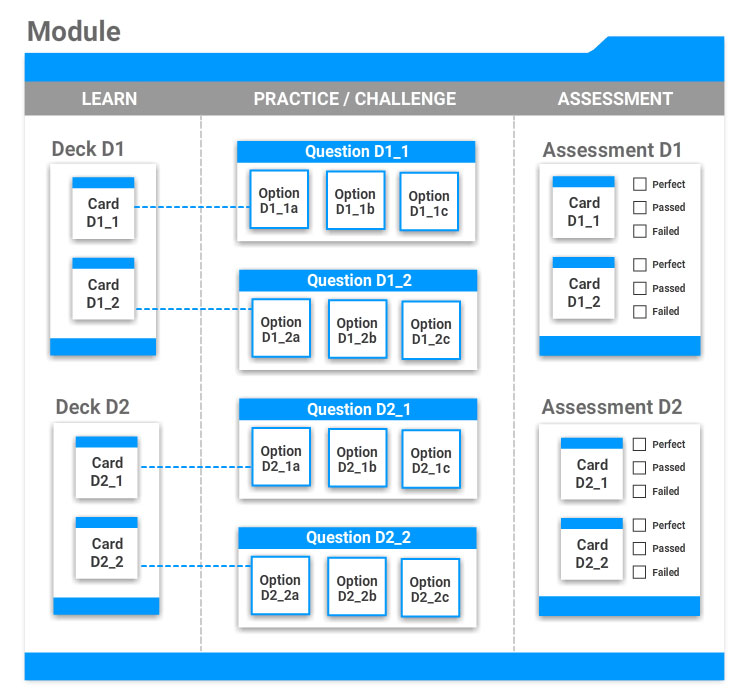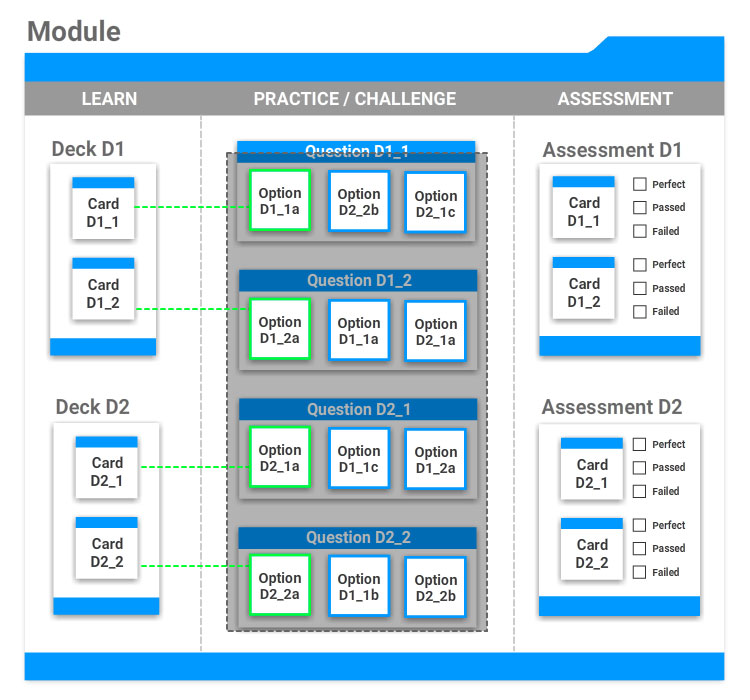How Deckspert Organizes Learning Content
The Deckspert “model” in this context refers to a data model. That just means how Deckspert organizes and manages your learning content: how the application breaks the content into “chunks” and establishes relations among those bits for the purposes of creating knowledge-checks (quizzes), challenges, and assessments.

The most important “content chunk” in Deckspert is right there in the name: the deck. A deck might contain a particular procedure, a short customer interaction, a set of similar products with lists of features and benefits, a task in an application or system, or simply a useful collection of tips and techniques. A card in a deck is best understood as the smallest teachable unit of content. This might be a step in a procedure, a response to a particular customer question, a single click in POS (point-of-sale) system task, or one the helpful tips you want to impart to your trainees.
A module is simply a collection of decks of the same type, usually grouped by learning objective or job task. For example, Sandwich Station might be the name of a module that contains procedural decks corresponding to all the different types of sandwiches a trainee needs to learn how to make. A Safety & Hygeine module could contain all the processes a new hire needs to master in that subject area.
Every module has four different modes: learn, practice, challenge and assessment. All these modes are created automatically, but you can customize which are of these are enabled for the learner depending on the training objectives of the module.
- Learn Mode for a module is simply the presentation of the learning content itself in several different formats.
- Practice Mode is a knowledge-check activity which uses the same data to create questions for the learner to answer in order to master the content.
- Challenge Mode is a timed test in which all of the decks in the module are covered. Think of it as the “final exam” for the entire module.
- Assessment Mode presents the content in the form of an observer checklist, so that a manager or qualified co-worker can observe the trainee performing the task and evaluate how well they execute each step or answer each question.
The diagram below shows how the decks and cards fit into the overall structure of the module. In Learn and Assessment modes, each deck functions as a standalone unit; in Practice and Challenge modes, the decks are sequenced together as a continuous series of questions or decision points. In other words, for the learner to master the Practice and Challenge modes of a module requires them to have mastered each and every deck inside it.

The diagram also introduces the last and smallest content unit in the Deckspert model: the option. In creating a card for a deck, you’ll also have created an option that corresponds to the card; that automatically generated option is the correct answer for the card’s challenge question.
For example, say I’m creating a deck for our Sandwich Station on how to make a peanut butter and jelly sandwich. When I create the card for adding the peanut butter, Deckspert will automatically create an option with the exact same content. When the learner goes to practice that deck, the correct option “Spread the peanut butter” will appear as one option among others (i.e., “Spread the jelly”,”Close the sandwich”, “Remove the crusts”).
In most cases, the option will have the exact same text as the card itself; however, you can change that text if you need to. For example, if you need to shorten the option text for the purposes of the quiz, you can without affecting the card because they are in fact two different pieces of data. In practice and challenge mode, the card can also have incorrect options associated with it, or what instructional designers call “distractors.” Options, to summarize, are the smallest content chunks in Deckspert . They are subordinate to cards since they exist only for the purposes of providing choices (correct and incorrect) to the learner in the practice and challenge modes.
Because the data from every deck is contained in the parent module, options can be shared across decks when you are creating practice questions. The below diagram shows how this works:

Compare this diagram to the previous one and notice that the identifiers for the options in the practice/challenge mode actually point to options from other decks. This may seem like an insignificant technical point, but it becomes important when you start creating knowledge-checks yourself in the Deckspert editor. When you are deciding on which incorrect options to add to your practice/challenge questions, you will notice that you have access to a library of all the options used in the module as a whole. This makes the process of creating new and more challenging questions much easier, for the simple reason that you’ll have a lot more options to choose from.
For more on designing and crafting effective practice and challenge modes for a module, see the User Guide sections on the individual Activity Types. Although there will be some variation in this process for each different activity, the underlying model outlined here is consistent across all of them.